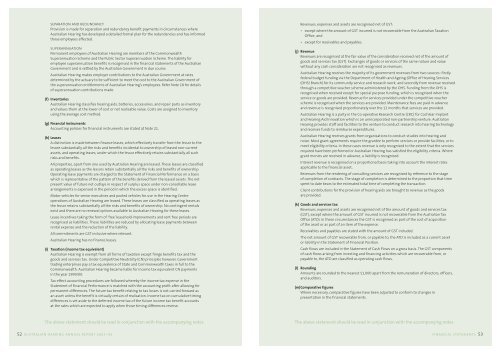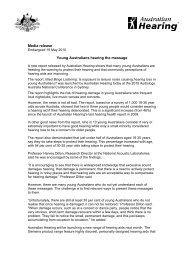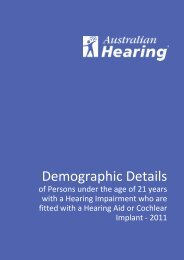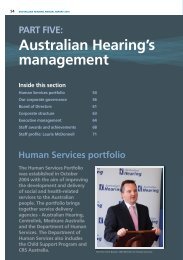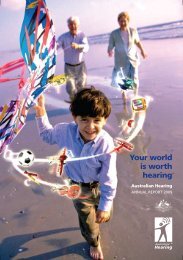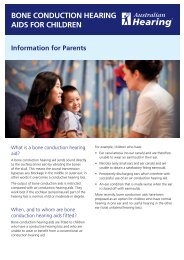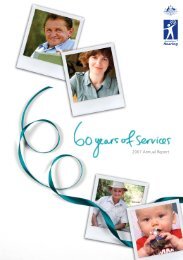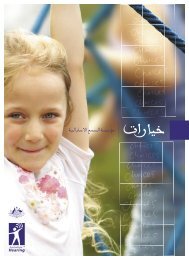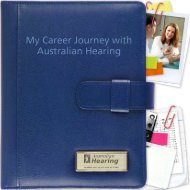Stralian Hearing Annual Report 2003â04 - Australian Hearing
Stralian Hearing Annual Report 2003â04 - Australian Hearing
Stralian Hearing Annual Report 2003â04 - Australian Hearing
You also want an ePaper? Increase the reach of your titles
YUMPU automatically turns print PDFs into web optimized ePapers that Google loves.
SEPARATION AND REDUNDANCY<br />
Provision is made for separation and redundancy benefit payments in circumstances where<br />
<strong>Australian</strong> <strong>Hearing</strong> has developed a detailed formal plan for the redundancies and has informed<br />
those employees affected.<br />
SUPERANNUATION<br />
Permanent employees of <strong>Australian</strong> <strong>Hearing</strong> are members of the Commonwealth<br />
Superannuation Scheme and the Public Sector Superannuation Scheme. The liability for<br />
employee superannuation benefits is recognised in the financial statements of the <strong>Australian</strong><br />
Government and is settled by the <strong>Australian</strong> Government in due course.<br />
<strong>Australian</strong> <strong>Hearing</strong> makes employer contributions to the <strong>Australian</strong> Government at rates<br />
determined by the actuary to be sufficient to meet the cost to the <strong>Australian</strong> Government of<br />
the superannuation entitlements of <strong>Australian</strong> <strong>Hearing</strong>’s employees. Refer Note 18 for details<br />
of superannuation contributions made.<br />
(f) Inventories<br />
<strong>Australian</strong> <strong>Hearing</strong> classifies hearing aids, batteries, accessories, and repair parts as inventory<br />
and values them at the lower of cost or net realisable value. Costs are assigned to inventory<br />
using the average cost method.<br />
(g) Financial instruments<br />
Accounting policies for financial instruments are stated at Note 21.<br />
(h) Leases<br />
A distinction is made between finance leases, which effectively transfer from the lessor to the<br />
lessee substantially all the risks and benefits incidental to ownership of leased non-current<br />
assets, and operating leases, under which the lessor effectively retains substantially all such<br />
risks and benefits.<br />
All properties, apart from one used by <strong>Australian</strong> <strong>Hearing</strong> are leased. These leases are classified<br />
as operating leases as the lessors retain substantially all the risks and benefits of ownership.<br />
Operating lease payments are charged to the Statement of Financial Performance on a basis<br />
which is representative of the pattern of the benefits derived from the leased assets. The net<br />
present value of future net outlays in respect of surplus space under non-cancellable lease<br />
arrangements is expensed in the period in which the excess space is identified.<br />
Motor vehicles for senior executives and pooled vehicles for use in the <strong>Hearing</strong> Centre<br />
operations of <strong>Australian</strong> <strong>Hearing</strong> are leased. These leases are classified as operating leases as<br />
the lessor retains substantially all the risks and benefits of ownership. No contingent rentals<br />
exist and there are no renewal options available to <strong>Australian</strong> <strong>Hearing</strong> for these leases.<br />
Lease incentives taking the form of ‘free’ leasehold improvements and rent free periods are<br />
recognised as liabilities. These liabilities are reduced by allocating lease payments between<br />
rental expense and the reduction of the liability.<br />
All commitments are GST inclusive where relevant.<br />
<strong>Australian</strong> <strong>Hearing</strong> has no finance leases.<br />
(i) Taxation (income tax equivalent)<br />
<strong>Australian</strong> <strong>Hearing</strong> is exempt from all forms of taxation except fringe benefits tax and the<br />
goods and services tax. Under Competitive Neutrality (CN) principles however, Government<br />
trading enterprises pay a tax equivalence of State and Commonwealth taxes in full to the<br />
Commonwealth. <strong>Australian</strong> <strong>Hearing</strong> became liable for income tax equivalent CN payments<br />
in the year 1999/00.<br />
Tax effect accounting procedures are followed whereby the income tax expense in the<br />
Statement of Financial Performance is matched with the accounting profit after allowing for<br />
permanent differences. The future tax benefit relating to tax losses is not carried forward as<br />
an asset unless the benefit is virtually certain of realisation. Income tax on cumulative timing<br />
differences is set aside to the deferred income tax of the future income tax benefit accounts<br />
at the rates which are expected to apply when those timing differences reverse.<br />
Revenues, expenses and assets are recognised net of GST:<br />
• except where the amount of GST incurred is not recoverable from the <strong>Australian</strong> Taxation<br />
Office; and<br />
• except for receivables and payables.<br />
( j) Revenue<br />
Revenues are recognised at the fair value of the consideration received net of the amount of<br />
goods and services tax (GST). Exchanges of goods or services of the same nature and value<br />
without any cash consideration are not recognised as revenues.<br />
<strong>Australian</strong> <strong>Hearing</strong> receives the majority of its government revenues from two sources: firstly<br />
federal budget funding via the Department of Health and Ageing (Office of <strong>Hearing</strong> Services<br />
(OHS) Branch) for its community service and research work; and secondly from revenue received<br />
through a competitive voucher scheme administered by the OHS. Funding from the OHS is<br />
recognised when received except for special purpose funding, which is recognised when the<br />
service or goods are provided. Revenue for services provided under the competitive voucher<br />
scheme is recognised when the services are provided. Maintenance fees are paid in advance<br />
and revenue is recognised proportionately over the 12 months that services are provided.<br />
<strong>Australian</strong> <strong>Hearing</strong> is a party in the Co-operative Research Centre (CRC) for Cochlear Implant<br />
and <strong>Hearing</strong> Aid Innovation which is an unincorporated non-partnership venture. <strong>Australian</strong><br />
<strong>Hearing</strong> provides staff and facilities to the venture to conduct research into hearing technology<br />
and receives funds to reimburse expenditures.<br />
<strong>Australian</strong> <strong>Hearing</strong> receives grants from organisations to conduct studies into hearing and<br />
noise. Most grant agreements require the grantee to perform services or provide facilities, or to<br />
meet eligibility criteria. In these cases revenue is only recognised to the extent that the services<br />
required have been performed or <strong>Australian</strong> <strong>Hearing</strong> has satisfied the eligibility criteria. Where<br />
grant monies are received in advance, a liability is recognised.<br />
Interest revenue is recognised on a proportional basis taking into account the interest rates<br />
applicable to the financial asset.<br />
Revenues from the rendering of consulting services are recognised by reference to the stage<br />
of completion of contracts. The stage of completion is determined to the proportion that time<br />
spent to date bears to the estimated total time of completing the transaction.<br />
Client contributions for the provision of hearing aids are brought to revenue as the goods<br />
are provided.<br />
(k) Goods and services tax<br />
Revenues, expenses and assets are recognised net of the amount of goods and services tax<br />
(GST), except where the amount of GST incurred is not recoverable from the <strong>Australian</strong> Tax<br />
Office (ATO). In these circumstances the GST is recognised as part of the cost of acquisition<br />
of the asset or as part of an item of the expense.<br />
Receivables and payables are stated with the amount of GST included.<br />
The net amount of GST recoverable from, or payable to, the ATO is included as a current asset<br />
or liability in the Statement of Financial Position.<br />
Cash flows are included in the Statement of Cash Flows on a gross basis. The GST components<br />
of cash flows arising from investing and financing activities which are recoverable from, or<br />
payable to, the ATO are classified as operating cash flows.<br />
(l) Rounding<br />
Amounts are rounded to the nearest $1,000 apart from the remuneration of directors, officers,<br />
and auditors.<br />
(m) Comparative figures<br />
Where necessary, comparative figures have been adjusted to conform to changes in<br />
presentation in the financial statements.<br />
The above statement should be read in conjunction with the accompanying notes<br />
52 AUSTRALIAN HEARING ANNUAL REPORT 2003–04<br />
The above statement should be read in conjunction with the accompanying notes<br />
FINANCIAL STATEMENTS 53


